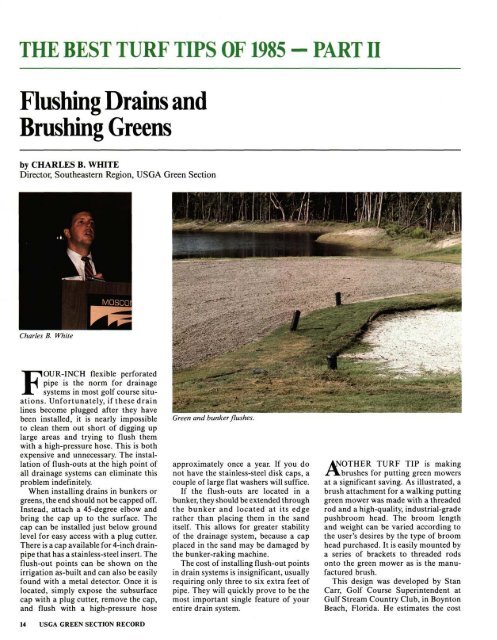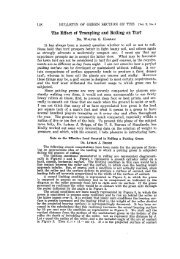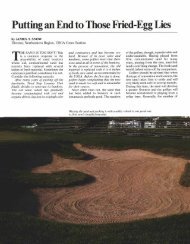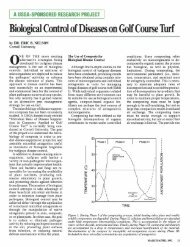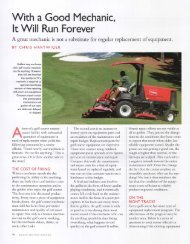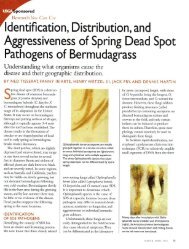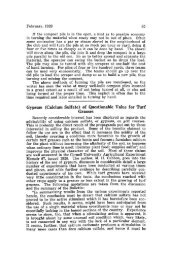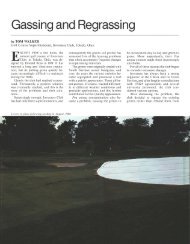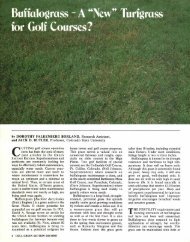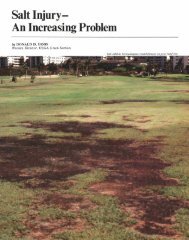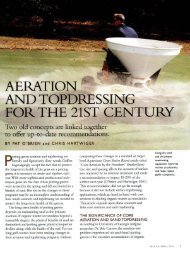Flushing Drains and Brushing Greens - USGA Green Section Record
Flushing Drains and Brushing Greens - USGA Green Section Record
Flushing Drains and Brushing Greens - USGA Green Section Record
You also want an ePaper? Increase the reach of your titles
YUMPU automatically turns print PDFs into web optimized ePapers that Google loves.
THE BEST TURF TIPS OF 1985 - PART II<strong>Flushing</strong> <strong>Drains</strong> <strong>and</strong><strong>Brushing</strong> <strong><strong>Green</strong>s</strong>by CHARLES B. WHITEDirector, Southeastern Region, <strong>USGA</strong> <strong>Green</strong> <strong>Section</strong>Charles B.• •31WhiteMoscormFOUR-INCH flexible perforatedpipe is the norm for drainagesystems in most golf course situations.Unfortunately, if these drainlines become plugged after they havebeen installed, it is nearly impossibleto clean them out short of digging uplarge areas <strong>and</strong> trying to flush themwith a high-pressure hose. This is bothexpensive <strong>and</strong> unnecessary. The installationof flush-outs at the high point ofall drainage systems can eliminate thisproblem indefinitely.When installing drains in bunkers orgreens, the end should not be capped off.Instead, attach a 45-degree elbow <strong>and</strong>bring the cap up to the surface. Thecap can be installed just below groundlevel for easy access with a plug cutter.There is a cap available for 4-inch drainpipethat has a stainless-steel insert. Theflush-out points can be shown on theirrigation as-built <strong>and</strong> can also be easilyfound with a metal detector. Once it islocated, simply expose the subsurfacecap with a plug cutter, remove the cap,<strong>and</strong> flush with a high-pressure hose14 <strong>USGA</strong> GREEN SECTION RECORD<strong>Green</strong> <strong>and</strong> bunkerflushes.approximately once a year. If you donot have the stainless-steel disk caps, acouple of large flat washers will suffice.If the flush-outs are located in abunker, they should be extended throughthe bunker <strong>and</strong> located at its edgerather than placing them in the s<strong>and</strong>itself. This allows for greater stabilityof the drainage system, because a capplaced in the s<strong>and</strong> may be damaged bythe bunker-raking machine.The cost of installing flush-out pointsin drain systems is insignificant, usuallyrequiring only three to six extra feet ofpipe. They will quickly prove to be themost important single feature of yourentire drain system.AOTHER TURF TIP is makingbrushes for putting green mowersat a significant saving. As illustrated, abrush attachment for a walking puttinggreen mower was made with a threadedrod <strong>and</strong> a high-quality, industrial-gradepushbroom head. The broom length<strong>and</strong> weight can be varied according tothe user's desires by the type of broomhead purchased. It is easily mounted bya series of brackets to threaded rodsonto the green mower as is the manufacturedbrush.This design was developed by StanCarr, Golf Course Superintendent atGulf Stream Country Club, in BoyntonBeach, Florida. He estimates the cost
Brush made with threaded rod <strong>and</strong> floor broom.of his brushes at about $11 each. Hefeels the industrial-type broom headgives better quality grooming than theconventional metal bristle brush. He isable to increase or decrease the vigorof the brushing by varying the weightof the brush on the surface or by changingthe brush head itself. Carr has alsoadapted the idea for brushes on triplexputting green units <strong>and</strong> brushes formatting-in topdressing.This is but one example of the tremendousresourcefulness that can be foundin the field of golf course management.Hydraulic Leak Warningby LARRY W. GILHULYDirector, Western Region, <strong>USGA</strong> <strong>Green</strong> <strong>Section</strong>\x^MOSCONLarry W. GilhulyA surefire wayto increaseStimpmeter readings.ONE OF THE MOST frighteningproblems that plague superintendentswho use triplexputting green mowers is the hydraulicleak. We have all seen damage thatranges from small dead areas every 10to 15 feet to massive lines of dead turfcovering several greens or tees. In thepast, a careful maintenance program<strong>and</strong> operator attention would be thebest answer to the problem. However,the golf course mechanic at SilveradoCountry Club, in Napa, California, hasdevised a method by which the operatoris warned about hydraulic leaks.The <strong>Green</strong> Sentinel operates at adetection level of five ounces of hydraulicMARCH/APRIL 1986 15


